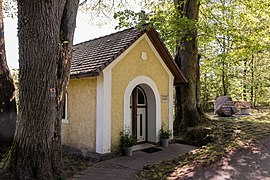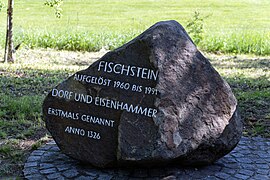Fish stone
|
Fish stone
Market Neuhaus an der Pegnitz
Coordinates: 49 ° 37 ′ 42 ″ N , 11 ° 33 ′ 6 ″ E
|
|
|---|---|
| Height : | approx. 390 m above sea level NHN |
| Residents : | 0 |
|
View of the Antonius Chapel
|
|
Fischstein was once a district of the market Neuhaus an der Pegnitz in the district of Nürnberger Land in Middle Franconia .
history
The third hammer mill was located in Fischstein in the area of the Neuhaus market. Today there is the Antonius Chapel ( location ). A boulder as a memorial with the inscription "Fischstein - dissolved 1960 to 1991 - village and Eisenhammer - first mentioned in 1326" was set up next to the chapel. On the holiday of Ascension Day 2001, the memorial stone received the church blessing as part of a traditional May service.
Its inhabitants had to leave ancient cultivated land to supply the city of Nuremberg with drinking water. For a long time the water from the nearby Haselhof springs was no longer sufficient. New sources had to be tapped. For this purpose, the villages of Oberbrand , Unterbrand and Rauhenstein had to be dissolved. Between 1960 and 1991, all properties were demolished and the residents were relocated, as the place was located in the narrower protection zone of the drinking water protection area designated in 1960 . Church and school the place was connected to Michelfeld . Today the area is part of the Pegnitzau nature reserve between Ranna and Michelfeld . The former local area is designated by the Bavarian State Office for the Preservation of Monuments as a ground monument (D-5-6335-0058).
The hammer and the village of Fischstein were first mentioned in a document from 1327. The Pogner family operated the hammer. The widow of Konrad Pogner, Kunigunde, "Dicto Pognerin de Auerbach, a Bona Matrona" (called the Pognerin from Auerbach, a good woman) gave ten rights to the Michelfeld monastery in 1333 . In 1398 the Alhart brothers from Amberg renounced "the Pognerin hamerstatt an der Pegnitz", the Hammer Fischstein, in favor of the Michelfeld Monastery. In 1406 the hammer came to the Auerbach family Stromeir (Stromer). In 1618 the city of Auerbach bought the hammer and a house, as well as the fishing and timber law for 7200 florints . Even after the Thirty Years' War it was still a viable rail hammer , at the same time a beautiful little castle, belonging to the town of Auerbach and subject to interest and taxes in Michelfeld (the monastery). On October 5, 1859, the city sold the property to the state, which ended the hammer operation. At that time, two of the 24 houses were ruins. The state had two more houses and the Kohlhütte demolished. Three more houses fell victim to the railway construction from 1876–1877.
Anthony's Chapel
In Fischstein, the small chapel was a center of the village. It was renovated in the 2010s and is looked after by former residents of the village. It is not possible to say exactly when the chapel was built. In any case, the chapel is said to have stood here for several centuries.
Personalities
The painter and philanthropist Lisl Kreuz (1923–2016) was born in Fischstein.
Picture gallery
Individual evidence
- ↑ BayernAtlas, Zeitreise, Fischstein around 1960 (accessed on June 3, 2019)
literature
- Nuremberg country . Karl Pfeiffer's Buchdruckerei und Verlag, Hersbruck 1993. ISBN 3-9800386-5-3
- Andreas Dimler: Marktgemeinde Neuhaus - Yesterday and Today , ISBN 3-9806507-1-5 .
Web links
- Fischstein - once a village and iron hammer on the Pegnitz , weber-rudolf.de
- Fischstein, historical map in the Bavaria Atlas (first photo, dated 1808–1864)
- AMS card 1: 25,000, based on a measuring table sheet from 1945 , landkartenarchiv.de





